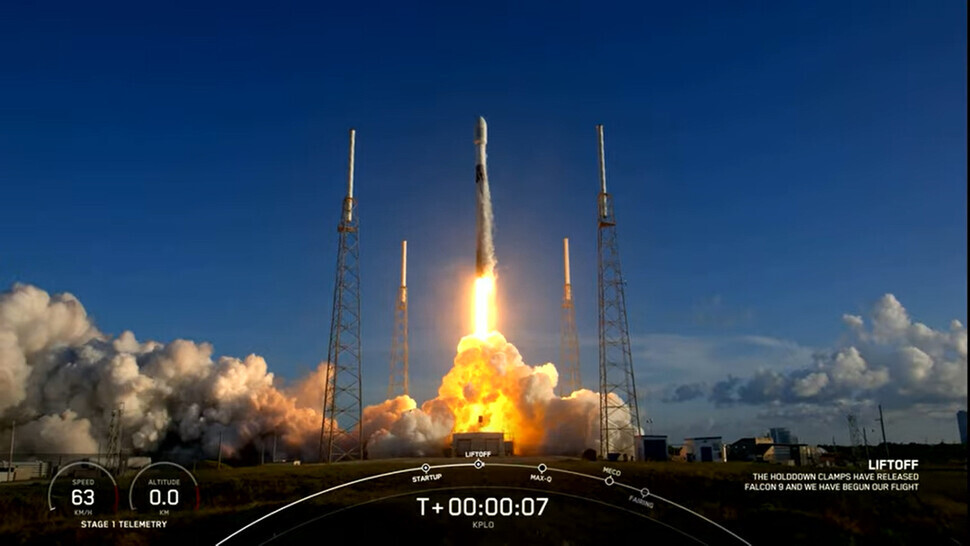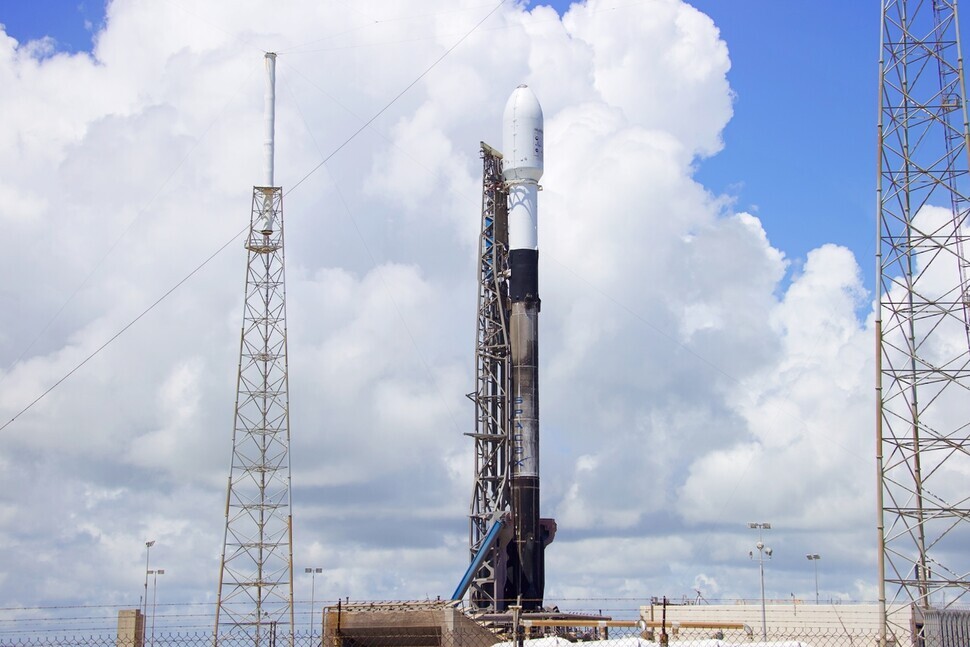hankyoreh
Links to other country sites 다른 나라 사이트 링크
Fly me to the moon: Korea’s first lunar orbiter takes off aboard SpaceX rocket

Danuri, South Korea’s very first lunar probe, successfully took the first step of its journey at 8:08 am on Friday.
Danuri, also known as the Korea Pathfinder Lunar Orbiter, lifted off at its originally scheduled time (7:08 pm Thursday local time) from a US Space Force base in Cape Canaveral, Florida, atop a SpaceX Falcon 9 rocket.
Danuri will be traveling through space for four and a half months before reaching lunar orbit on Dec. 16.
The Ministry of Science and ICT stated, “It’s expected that the Korea Aerospace Research Institute (KARI) will be able to check whether Danuri successfully entered the moon transfer trajectory we aimed for around 1 to 2 pm [5 to 6 hours after launch] by analyzing projectile separation data.”
If Danuri successfully reaches the moon this upcoming December and begins its probe mission, South Korea will be the seventh country in the world to explore the moon after the US, Russia, Europe, Japan, China, and India.
The lunar orbiter was scheduled to separate 40 minutes and 23 seconds (2,423 seconds) after lift-off, 4 minutes and 30 seconds after which it was set to enter the moon transfer trajectory. Danuri’s location at the time of transfer was about 1,655 kilometers away from Earth. Starting then, the automatic programs set up on the computer installed in the orbiter were set to launch, unfolding the orbiter’s solar panel. Six minutes later (51 minutes after lift-off), the orbiter was expected to position itself to face the sun, after which its solar panel would begin to generate electricity.

Ten minutes later (60 minutes after lift-off), the orbiter was set to communicate with the ground station on Earth for the first time, allowing KARI’s ground station to start inspecting the lunar orbiter. The ground station will subsequently continue to communicate with the orbiter, carrying out trajectory correction maneuvers several times so that Danuri can navigate space following the ballistic lunar transfer trajectory for four and a half months.
After traveling through space following the moon transfer orbit for four and a half months, Danuri will reach the moon’s orbit around Dec. 16. At that point, it will go through a two-week process of entering the circular orbit that passes through the moon’s polar region from an altitude of 100 kilometers, after which trial operation will begin starting January next year. Inspecting whether payloads are working properly and whether various optical benches are taking video footage as designed is also necessary.
Once the inspection is complete, Danuri will be orbiting the moon 12 times a day from February to late December next year, carrying out its mission of observing the moon and other scientific-technological missions.
By Lee Keun-young, senior staff writer
Please direct questions or comments to [english@hani.co.kr]

Editorial・opinion
![[Column] Season 2 of special prosecutor probe may be coming to Korea soon [Column] Season 2 of special prosecutor probe may be coming to Korea soon](https://flexible.img.hani.co.kr/flexible/normal/500/300/imgdb/original/2024/0426/3317141030699447.jpg) [Column] Season 2 of special prosecutor probe may be coming to Korea soon
[Column] Season 2 of special prosecutor probe may be coming to Korea soon![[Column] Park Geun-hye déjà vu in Yoon Suk-yeol [Column] Park Geun-hye déjà vu in Yoon Suk-yeol](https://flexible.img.hani.co.kr/flexible/normal/500/300/imgdb/original/2024/0424/651713945113788.jpg) [Column] Park Geun-hye déjà vu in Yoon Suk-yeol
[Column] Park Geun-hye déjà vu in Yoon Suk-yeol- [Editorial] New weight of N. Korea’s nuclear threats makes dialogue all the more urgent
- [Guest essay] The real reason Korea’s new right wants to dub Rhee a founding father
- [Column] ‘Choson’: Is it time we start referring to N. Korea in its own terms?
- [Editorial] Japan’s rewriting of history with Korea has gone too far
- [Column] The president’s questionable capacity for dialogue
- [Column] Are chaebol firms just pizza pies for families to divvy up as they please?
- [Column] Has Korea, too, crossed the Rubicon on China?
- [Correspondent’s column] In Japan’s alliance with US, echoes of its past alliances with UK
Most viewed articles
- 1AI is catching up with humans at a ‘shocking’ rate
- 2Korea’s 1.3% growth in Q1 signals ‘textbook’ return to growth, says government
- 3Is Japan about to snatch control of Line messenger from Korea’s Naver?
- 4After election rout, Yoon’s left with 3 choices for dealing with the opposition
- 5No good, very bad game for Korea puts it out of Olympics for first time since 1988
- 6Will NewJeans end up collateral damage in internal feud at K-pop juggernaut Hybe?
- 7[Column] Season 2 of special prosecutor probe may be coming to Korea soon
- 81 in 5 unwed Korean women want child-free life, study shows
- 9[Column] Park Geun-hye déjà vu in Yoon Suk-yeol
- 10‘We must say no’: Seoul defense chief on Korean, USFK involvement in hypothetical Taiwan crisis